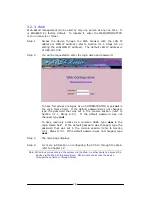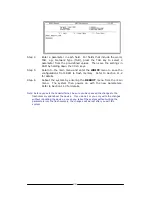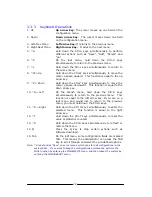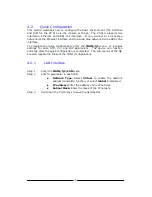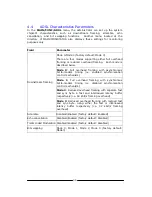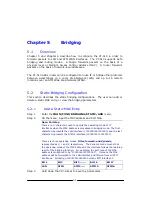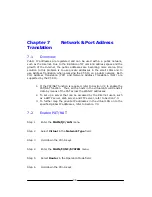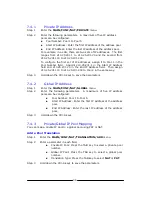
27
ATM VC:
The virtual channel number corresponds to the ATM
interface, e.g., ATM1 to VC1, or ATM2 to VC2. You should enter
the ATM VC menu (refer to Section 4.2.3) to configure the VC
parameters. For example, if this field displays VC2, enter the
MAIN/QC/VC/VC2
menu to configure the VC2 parameters.
IP address:
Enter the address of the IP network.
Subnet mask:
Enter the mask of the IP network.
Operation Mode
: Router/Bridge
Step 4 Hold down the Ctrl-S keys to save the parameters.
Note: For PPP or PPPOE protocol, if the Dynamic function is selected in the
IPCP field, your ISP IP server will auto-assign an IP address and subnet
mask to the device. You can enter the
MAIN/MON/ATM
menu to see
what IP address and subnet the device is assigned.
4.2.3
ATM VC Parameters
The CT-510 supports 16 virtual channels.
Step 1 Enter the
MAIN/QC/VC
menu.
Step 2 Enter a VC leaf menu, VC1 to VC16, e.g., MAIN/QC/VC/VC1.
Step 3 Enter a parameter in each field.
VPI/VCI:
Enter the value of VPI and VCI.
VPI –
The Virtual Path Identifier (VPI) is part of the cell header
for the cells that are transferred over this connection. The VPI
value ranges between zero and 255.
VCI –
The Virtual Channel Identifier (VCI) is part of the cell
header for the cells that are transferred over this connection. If
you are configuring multiple VCs, enter the number of the
corresponding VC in this field. The VCI value ranges between 33
and 65534.
AAL5 Encapsulation
VCMUX –
VC-based multiplexing for the PPP and PPPOE
protocols
LLC –
LLC encapsulation for the PPP protocol
VC QOS
UBR –
Unspecified Bit Rate. No limit has been specified for the
information rate.
CBR –
Constant Bit Rate. This class is used for emulating circuit
switching. The cell rate is constant with time. CBR applications
are quite sensitive to cell-delay variation. Examples of
applications that can use CBR are telephone traffic (i.e., nx64
kbps), videoconferencing, and television.
rtVBR –
Real-time Variable Bit Rate. This class is similar to
nrtVBR but is designed for applications that are sensitive to
cell-delay variation. Examples for real-time VBR are voice with
speech activity detection (SAD) and interactive compressed
video.






